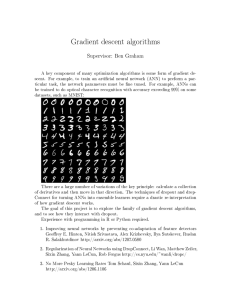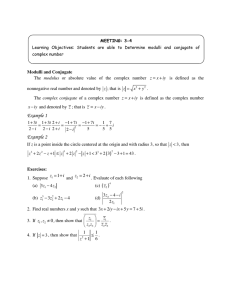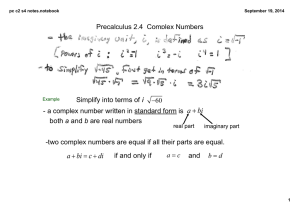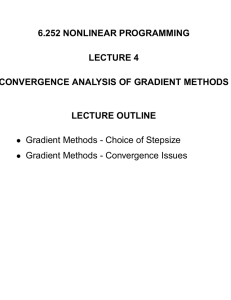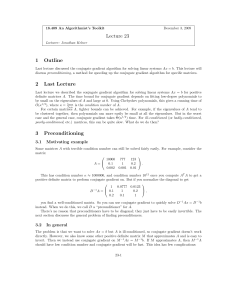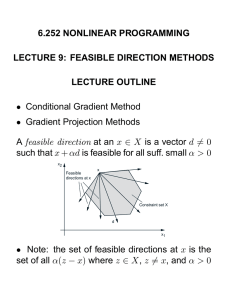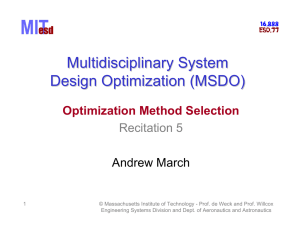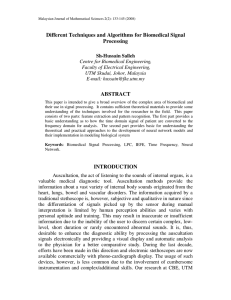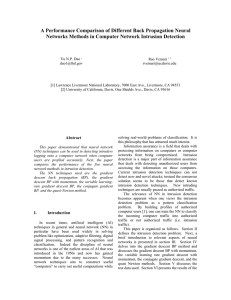Document 13501733
advertisement
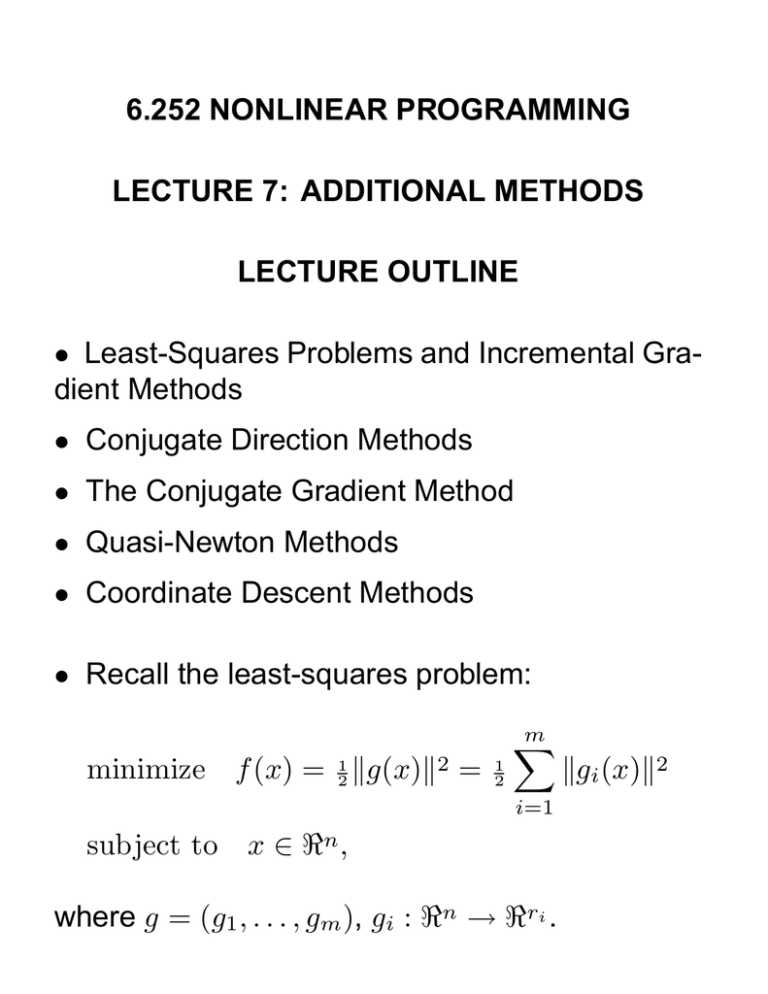
6.252 NONLINEAR PROGRAMMING LECTURE 7: ADDITIONAL METHODS LECTURE OUTLINE • Least-Squares Problems and Incremental Gradient Methods • Conjugate Direction Methods • The Conjugate Gradient Method • Quasi-Newton Methods • Coordinate Descent Methods • Recall the least-squares problem: minimize f (x) = 12 g(x)2 = 1 2 m gi (x)2 i=1 subject to x ∈ n , where g = (g1 , . . . , gm ), gi : n → ri . INCREMENTAL GRADIENT METHODS • Steepest descent method xk+1 = xk −αk ∇f (xk ) = xk −αk m ∇gi (xk )gi (xk ) i=1 • Incremental gradient method: ψi = ψi−1 − αk ∇gi (ψi−1 )gi (ψi−1 ), ψ0 = xk , i = 1, . . . , m xk+1 = ψm (ai x - bi )2 x* mini ai bi R Advantage of incrementalism max i ai bi x VIEW AS GRADIENT METHOD W/ ERRORS • Can write incremental gradient method as xk+1 = xk − αk m ∇gi (xk )gi (xk ) i=1 + αk m ∇gi (xk )gi (xk ) − ∇gi (ψi−1 )gi (ψi−1 ) i=1 • Error term is proportional to stepsize αk • Convergence (generically) for a diminishing stepsize (under a Lipschitz condition on ∇gi gi ) • Convergence to a “neighborhood” for a constant stepsize CONJUGATE DIRECTION METHODS • Aim to improve convergence rate of steepest descent, without incurring the overhead of Newton’s method • Analyzed for a quadratic model. They require n iterations to minimize f (x) = (1/2)x Qx − b x with Q an n × n positive definite matrix Q > 0. • Analysis also applies to nonquadratic problems in the neighborhood of a nonsingular local min • Directions d1 , . . . , dk are Q-conjugate, if di Qdj = 0 for all i = j • Generic conjugate direction method: xk+1 = xk + αk dk where the dk s are Q-conjugate and αk is obtained by line minimization y0 y1 y2 w1 x0 x1 d 0 = Q -1/2w0 w0 x2 d 1 = Q -1/2w1 Expanding Subspace Theorem GENERATING Q-CONJUGATE DIRECTIONS • Given set of linearly independent vectors ξ 0 , . . . , ξ k , we can construct a set of Q-conjugate directions d0 , . . . , dk s.t. Span(d0 , . . . , di ) = Span(ξ 0 , . . . , ξ i ) • Gram-Schmidt procedure. Start with d0 = ξ 0 . If for some i < k, d0 , . . . , di are Q-conjugate and the above property holds, take di+1 = ξ i+1 + i c(i+1)m dm ; m=0 choose c(i+1)m so di+1 is Q-conjugate to d0 , . . . , di , di+1 Qdj = ξ i+1 Qdj + i c(i+1)m dm Qdj = 0. m=0 d 2= ξ2 + c20d 0 + c21d 1 d 1= ξ1 + c10d 0 ξ2 ξ1 d1 0 0 - c10d 0 ξ0 = d0 d0 CONJUGATE GRADIENT METHOD • Apply Gram-Schmidt to the vectors ξ k = g k = ∇f (xk ), k = 0, 1, . . . , n − 1 dk = −g k + k−1 j=0 g k Qdj j d j j d Qd • Key fact: Direction formula can be simplified. Proposition : The directions of the CGM are generated by d0 = −g 0 , and dk = −g k + β k dk−1 , k = 1, . . . , n − 1, where β k is given by k gk g βk = g k−1 g k−1 or k − g k−1 ) g k (g βk = g k−1 g k−1 Furthermore, the method terminates with an optimal solution after at most n steps. • Extension to nonquadratic problems. QUASI-NEWTON METHODS • xk+1 = xk − αk Dk ∇f (xk ), where Dk is an inverse Hessian approximation • Key idea: Successive iterates xk , xk+1 and gradients ∇f (xk ), ∇f (xk+1 ), yield curvature info q k ≈ ∇2 f (xk+1 )pk , pk = xk+1 − xk , q k = ∇f (xk+1 ) − ∇f (xk ). −1 2 n 0 n−1 0 n−1 p ··· p ∇ f (x ) ≈ q · · · q • Most popular Quasi-Newton method is a clever way to implement this idea Dk+1 k pk k q k q k Dk p D k τ k vk vk , = Dk + − + ξ q k Dk q k pk q k k k qk p D vk = − k , τ pk q k τ k = q k Dk q k , 0 ≤ ξk ≤ 1 and D0 > 0 is arbitrary, αk by line minimization, and Dn = Q−1 for a quadratic. NONDERIVATIVE METHODS • Finite difference implementations • Forward and central difference formulas ∂f (xk ) 1 k + he ) − f (xk ) f (x ≈ i h ∂xi 1 ∂f (xk ) k k f (x + hei ) − f (x − hei ) ≈ i 2h ∂x • Use central difference for more accuracy near convergence • xk+1 xk xk+2 Coordinate descent. Applies also to the case where there are bound constraints on the variables. • Direct search methods. Nelder-Mead method. PROOF OF CONJUGATE GRADIENT RESULT • Use induction to show that all gradients g k generated up to termination are linearly independent. True for k = 1. Suppose no termination after k steps, and g 0 , . . . , g k−1 are linearly independent. Then, Span(d0 , . . . , dk−1 ) = Span(g 0 , . . . , g k−1 ) and there are two possibilities: − g k = 0, and the method terminates. − g k = 0, in which case from the expanding manifold property g k is orthogonal to d0 , . . . , dk−1 g k is orthogonal to g 0 , . . . , g k−1 so g k is linearly independent of g 0 , . . . , g k−1 , completing the induction. • Since at most n lin. independent gradients can be generated, g k = 0 for some k ≤ n. • Algebra to verify the direction formula.


